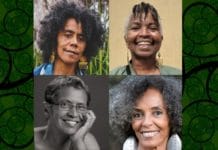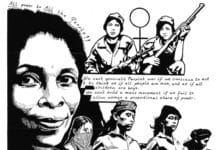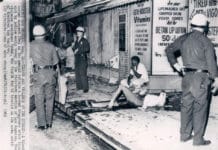by Marc Sapir, MD
Violence in the USA is bound to a culture of enforced inequality – internationally, nationally and locally. Similar to what has been happening in Mexico in recent years, much U.S. violence – whether committed by the mentally ill, by enraged individuals, by political actors, by gangs or by government agents – is often perpetrated against innocent and powerless people. Gun violence probably won’t lessen until we answer the question of how and why violence is so deeply embedded in this culture. Let’s try to solve that riddle as a community.
I wrote the letter below to Philip Maldari of KPFA 94.1 FM who has, so far, not responded. Although I had not intended it for publication, I e-copied a few people including the SF BayView’s editor (a friend), who then requested permission to publish it. I agreed to publication, but I do want to add a broader comment, which you will find after the letter. Although I am far from an expert on weapons, I think the postscript is necessary to clarify my broader views on the subject.
Philip,

I mean, John Kerry was a hero for us in the 1970s, but now he’s a war monger as much as Hillary Clinton, yet Bob found no problem with him as the possible next secretary of state. Kerry’s votes and statements in support of the wars and militarism aren’t concealed. They’re public knowledge.
Though I usually think your devil’s advocate style works well with Bob, I thought you didn’t help the discussion this time. I’m only going to comment on the one discussion about gun control, using it as an example, to hopefully clarify what I mean.
If one listened carefully to the callers, one can find a counterargument thread to outlawing guns that is rational but wasn’t brought out. It didn’t come from a single person (unfortunately) but can be pieced together from several.
For instance, a former advertising fellow from Marin talked about the purveying of fear in the media overall, heightened by the right, Fox and NRA types with the explicit aim of selling guns to the most paranoid people in the country “so they can defend themselves from – the other, the scourge, the terrorists, the Blacks, the government.” And those are the ideas and feelings that lead to a lot of the killings.
This culture of alienation, fear, paranoia, military thinking, was, after all, the theme of Michael Moore’s “Bowling for Columbine” – so easily forgotten and relegated to the past – that no country promotes fear, violence and militarism as part of its base culture the way the U.S. does. So, yes, fewer people would be killed by guns if guns were less available, but would the U.S. then become a less violent society? The jury is out on this, of course, but one can at least surmise a reasonable answer as Michael Moore did: probably not.
When you and Bob characterize the left view of gun ownership as being individual self-defense against the “police state,” I don’t think that’s exactly right. Bob even went so far as to point out – using a number of pejoratives – that having guns in Oakland’s volatile street culture of drugs and gangs isn’t about defending anything, but is just about killing innocent people. Of course that is true in general.
But can we really afford to have KPFA not mention, in the same discussion of gun violence, Oscar Grant and those two military vets who were shot by cops at Occupy protests? The number of police murders across the U.S. each year is vast and well documented – many hundreds. How does that factor into the discussion of solutions? To not do so is to ignore the situation of the communities we are supposed to be serving and representing – i.e. the unrepresented.
Violence in the USA is bound to a culture of enforced inequality – internationally, nationally and locally. Similar to what has been happening in Mexico in recent years, much U.S. violence – whether committed by the mentally ill, by enraged individuals, by political actors, by gangs or by government agents – is often perpetrated against innocent and powerless people. Gun violence probably won’t lessen until we answer the question of how and why violence is so deeply embedded in this culture.
What I am saying isn’t an argument for gun ownership per se. It is an argument against the one-sided presentation that the state’s arms are more rational, therefore benign, than the thugs’ guns or guns in the hands of the mentally unstable. They may be more rational but they aren’t more benign.
A decent argument needs to be had on all this but certainly disarming the cops, changing their social role and preventing the drones and tanks from reaching the police departments is part of that discussion. At least the people of Albany and Berkeley stopped the latter even though their liberal governments were about to bite at the wonderful offer of APCs (armored personnel vehicles).

To disconnect these issues is to imply that the problem originates in the chaos below rather than the constructs – and dominance of culture and ideology – from above. Solving such problems as gun violence is obviously a much more complex issue than you or Bob were willing to tackle.
The “let’s do something about this insanity now” may feel good, but it’s probably not efficacious, though you usually conduct pretty well thought out discussions. We know what happens with prohibitions – alcohol, drugs and probably also firearms. And when it comes to enforcement, it won’t be the right that will be targeted – nor the left organizations per se. It will be mainly Blacks and Latinos – as usual. Perhaps now we could add in Muslims and Arabs and South Asians.
When Scheer talked about some leftists paranoid about the FBI that isn’t coming after them, he was betraying how much he no longer has any sensibility of what it means to be living in places like East Oakland, Hunters Point and East LA these days. (By the way, these are my patients, the people I work with and care for.)
Sure, the people there are sick and tired and scared of the irrational violence and the death of their children, sisters, brothers, uncles. But the youth in particular – and as well all Black and Latino men – have every reason to fear for their lives from the police as the forces of the state, and the paths out of the cycle of their oppression and self-oppression are every day becoming fewer and narrower.
That doesn’t mean people should have piles of weapons on an individual basis to “defend” themselves and kill their families and neighbors, any more than the left should advance a crude rightist theory of individual armed self-defense. Those arguments, as you say, are nonsense.
A decent argument needs to be had on all this but certainly disarming the cops, changing their social role and preventing the drones and tanks from reaching the police departments is part of that discussion.
The converse, though, is salient. Outlawing guns can, and most likely would, be used to further inject police state behaviors into oppressed communities in an ongoing and escalating fashion – the stops in Oakland, now abandoned, looking for undocumented, would be replaced by stops looking for guns etc. Unless you contextualize all this, you seem to put yourselves on the side of the state power that exists to assure and enforce inequality in perpetuity.
I think that a fundamental disagreement at KPFA about what the station should be and who it should be for is embedded in this discussion. In desperation, some communities of color might well vote, if asked to do so, for gun control, but the young frisky youths – many of whom are not engaged in drugs and guns and violence, but who are often getting into trouble, who can easily fall into such traps given few alternatives and the general culture of violence and fear that surrounds them – would likely be driven either toward total passivity, terminal depression and mental illness or toward greater collectivized alienation through gangs – which will steal the guns – and such.

There are things we can do, like working to expose the gun lobby and NRA hyping and promoting community wide discussion about the sources of violence and selfishness – both material and emotional – in our culture aiming to create countercultures for youth that work for them. I think that “Bowling for Columbine” is a reasonable starting point on that, but Bob Scheer’s hysterical comments were less than helpful.
When someone called in about some successes with armed home defense in the Black South during civil rights – he had heard about it from (KPFA programmer) Robbie Osman – Bob dismissed the point by stating the fact that it was non-violent mass civil disobedience that achieved desegregation of the South. Of course that is true, but the dismissal of the other example has racial implications.
Was Scheer saying that people who defended themselves collectively with arms should not have had them or should not have used them? He could have pointed out the relative greater importance of the non-violent resistance in the South without going so far as to dismiss the caller and the other tactic. Was the IRA, the ANC, the NLF right or wrong to have a legal non-violent political apparatus, but as well an armed underground? Who gets to judge that?
History seems to answer the question based upon particular situations and their outcomes. The armed underground nature of the second Intifada, I have heard, did great damage to the cohesive culture of Palestinian resistance developed in the first (non-violent) Intifada. But why? Probably because it replaced that well-developed cohesive culture.
In many areas of thought and life a perspective of “either one or the other” seems to me historically outmoded and counterproductive. In the U.S. an effective response to social violence requires the birth of a broad cultural movement in resistance to the violence of the United States “state” and of various forms of bigotry and alienation that are allowed to thrive here.
Commentary
To address the practical aspect of preventing gun violence in our country, there are at least four separable issues involving guns that ought to be widely discussed. The first is the manufacture, advertising and promotion of guns as signifiers of power and autonomy. As with Wall Street and the banks, the government is not prepared to regulate this area sufficiently to protect the public interest.
The second area involves assuring that gun sales and purchases require adequate wait time for clearance of the buyer’s history regarding mental illness, DUIs, drug addiction, sexual predation of any type, violence against women and conviction for violent crimes. These restrictions seem to me a rational use of law and of government authority, but the laws in this area of sales are not well enforced and often the government doesn’t require the full medico-legal background investigation.
The third area has to do with types of weapons that are legally sold. “Macho” military weapons should not be in the hands of either police or the public. But both have easy access. AK-47s, AR-15s, M-16s and the like are mainly sold and purchased by people who are hyping and being hyped by militarism and violence, whether they be loners – who are particularly likely to go off and kill people – gangs or militias, or others who envision themselves as following God’s direction to prepare for war with demons of any type.

Automatic weapons such as the three mentioned fire continuously if the trigger is held back. Semi-automatic weapons do not. The military-style weapons that are sold legally in the U.S. have been re-engineered to not fire automatically, but people find ways to convert them back into rapid-fire military weapons. And since the two look exactly alike and are sold under the same name, automatic weapons can be passed off as legal ones, so the semi-automatic military look alikes should be prohibited; and the police should be prohibited from obtaining and using them and the automatic versions also. The goal should be to demilitarize our police, not to militarize them.
But the fourth and most important distinct area for discussion, in my opinion, is the possession of guns. I’ve heard estimates that there are 300 million guns held by the public in the U.S. today. Efforts to try and make the possession of guns illegal in a general sense, will inevitably end up – like the war on drugs – focused on expanded police and military harassment, invasion and attacks on the poor and particularly the Black and Brown urban communities throughout the country.
My letter to Philip Maldari was directed to this danger of making gun possession illegal. Gun possession can be licensed, requiring that people who purchase guns pass a hands-on test on safety, gun handling, care, cleaning and storage methods to reduce the danger that others – especially children – will gain access. Would changes in sales, promotion, restrictions on manufacture and licensing end the danger of irrational or organized gun violence and massacres in the U.S.? Certainly not.
But these general measures could move the cultural discussion and peoples’ behaviors in the right direction, whereas a focus on restricting gun ownership – except for people who fit appropriate medico-legal exclusion criteria – will probably worsen our cultural crisis, increase discrimination and police attacks, and increase the danger of greater social violence and chaos.
Marc Sapir is a practicing primary care physician in the East Bay. He can be reached at marcsapir@gmail.com.

 Store
Store







